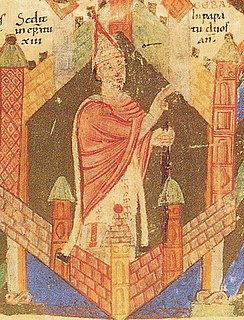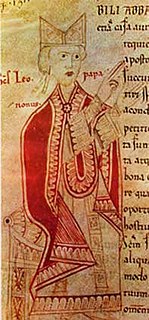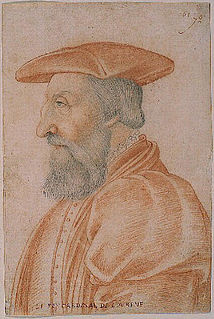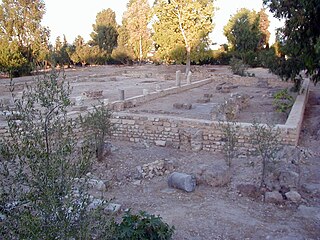Related Research Articles
Pope Stephen IX was the head of the Catholic Church and ruler of the Papal States from 3 August 1057 to his death. He was a member of the Ardenne-Verdun family, who ruled the Duchy of Lorraine, and started his ecclesiastical career as a canon in Liège. He was invited to Rome by Pope Leo IX, who made him chancellor in 1051 and one of three legates to Constantinople in 1054. The failure of their negotiations with Patriarch Michael I Cerularius of Constantinople and Archbishop Leo of Ohrid led to the permanent East-West Schism. He continued as chancellor to the next pope, Victor II, and was elected abbot of the Benedictine monastery of Montecassino.

Pope Victor II, born Gebhard of Dollnstein-Hirschberg, was the head of the Catholic Church and ruler of the Papal States from 13 April 1055 until his death in 1057. Victor II was one of a series of German-born popes who led the Gregorian Reform.
The 1050s was a decade of the Julian Calendar which began on January 1, 1050, and ended on December 31, 1059.

Pope Leo IX, born Bruno von Egisheim-Dagsburg, was the head of the Catholic Church and ruler of the Papal States from 12 February 1049 to his death in 1054. Leo IX is considered to be one of the most historically significant popes of the Middle Ages; he was instrumental in the precipitation of the Great Schism of 1054, considered the turning point in which the Catholic and Eastern Orthodox Churches formally separated. He is venerated as a saint in the Catholic Church.
Benedict X, born Giovanni, was elected to succeed Pope Stephen IX on 5 April 1058, but was opposed by a rival faction that elected Nicholas II. He fled Rome on 24 January 1059 and is today generally regarded as an antipope.

Jean de Lorraine was the third son of the ruling Duke of Lorraine, and a French cardinal, who was archbishop of Reims (1532–1538), Lyon (1537–1539), and Narbonne (1524–1550), bishop of Metz, and Administrator of the dioceses of Toul, Verdun, Thérouanne, Luçon, Albi, Valence, Nantes and Agen (1538–1550). He was a personal friend, companion, and advisor of King Francis I of France. Jean de Lorraine was the richest prelate in the reign of Francis I, as well as the most flagrant pluralist. He is one of several cardinals known as the Cardinal de Lorraine.
Honorius II, born Pietro Cadalo, was an antipope from 1061 to 1072. He was born in the County of Verona, and became bishop of Parma in 1045. He died at Parma in 1072.

The Archdiocese of Reims is a Latin Church ecclesiastic territory or archdiocese of the Catholic Church in France. Erected as a diocese around 250 by St. Sixtus of Reims, the diocese was elevated to an archdiocese around 750. The archbishop received the title "primate of Gallia Belgica" in 1089.

The Diocese of Beauvais, Noyon, and Senlis is a Latin Church ecclesiastical territory or diocese of the Catholic Church in France. The diocese encompasses the department of Oise in the region of Hauts-de-France. The diocese is a suffragan of the metropolitan Archdiocese of Reims. The current bishop is Jacques Benoit-Gonnin, appointed in 2010.

Gerard was a German prelate who served as the Bishop of Toul from 963 until his death. His entrance into the priesthood came about due to his mother being struck dead in a lightning strike which he believed was divine judgment for his sins and a call to service. But he had been known for his piousness and he accepted the position to the Toul diocese despite his reluctance. His concern as a bishop was to the restoration of all properties the Church managed and to ensure secular involvement in Church affairs ceased.

The Diocese of Toul was a Roman Catholic diocese seated at Toul in present-day France. It existed from 365 until 1824. From 1048 until 1552, it was also a state of the Holy Roman Empire.

The Roman Catholic Diocese of Autun (–Chalon-sur-Saône–Mâcon–Cluny), more simply known as the Diocese of Autun, is a diocese of the Latin Rite of the Roman Catholic Church in France. The diocese comprises the entire Department of Saone et Loire, in the Region of Bourgogne.

The Diocese of Nancy and Toul is a Latin Church ecclesiastical territory or diocese of the Catholic Church in France. After a considerable political struggle between Louis XV, Louis XVI, and the Dukes of Lorraine, the diocese was erected by Pope Pius VI on 17 December 1777. The Diocese of Nancy is a suffragan diocese in the ecclesiastical province of the metropolitan Archdiocese of Besançon.
Reims, located in the north-east of modern France, hosted several councils or synods in the Roman Catholic Church. These councils did not universally represent the church and are not counted among the official ecumenical councils.

The Diocese of Civitavecchia-Tarquinia is a Latin Church ecclesiastical territory or diocese of the Catholic Church in Lazio, Italy. It was established under this name in 1986. The diocese is immediately exempt to the Holy See and not part of an ecclesiastical province.
Halinard was the Archbishop of Lyon between 1046 and 1052; he also served as abbot of the monastery of Saint-Bénigne in Dijon between 1031 and 1052. He was a counselor of both the Emperor Henry III and Pope Victor II.
Adalbero III of Luxembourg was a German nobleman. He was a titular Count of Luxembourg and Bishop of Metz.

The Archdiocese of Carthage, also known as the Church of Carthage, was a Latin Catholic diocese established in Carthage, Roman Empire, in the 2nd century. Agrippin was the first named bishop, around 230 AD. The temporal importance of the city of Carthage in the Roman Empire had previously been restored by Julius Caesar and Augustus. When Christianity became firmly established around the Roman province of Africa Proconsulare, Carthage became its natural ecclesiastical seat. Carthage subsequently exercised informal primacy as an archdiocese, being the most important center of Christianity in the whole of Roman Africa, corresponding to most of today's Mediterranean coast and inland of Northern Africa. As such, it enjoyed honorary title of patriarch as well as primate of Africa: Pope Leo I confirmed the primacy of the bishop of Carthage in 446: "Indeed, after the Roman Bishop, the leading Bishop and metropolitan for all Africa is the Bishop of Carthage."

Peter of Brixey was Bishop of Toul from 1167 to 1192, and a supporter of the Holy Roman Emperor Frederick Barbarossa in the late twelfth-century phase of the Investiture Controversy, one of the few bishops of Lorraine to do so.
Robert of Nantes was the Latin patriarch of Jerusalem from 1240 to 1254.
References
- ↑ Mann, Horace. "Pope St. Leo IX." The Catholic Encyclopedia Vol. 9. New York: Robert Appleton Company, 1910. 12 May 2019
 This article incorporates text from this source, which is in the public domain .
This article incorporates text from this source, which is in the public domain .